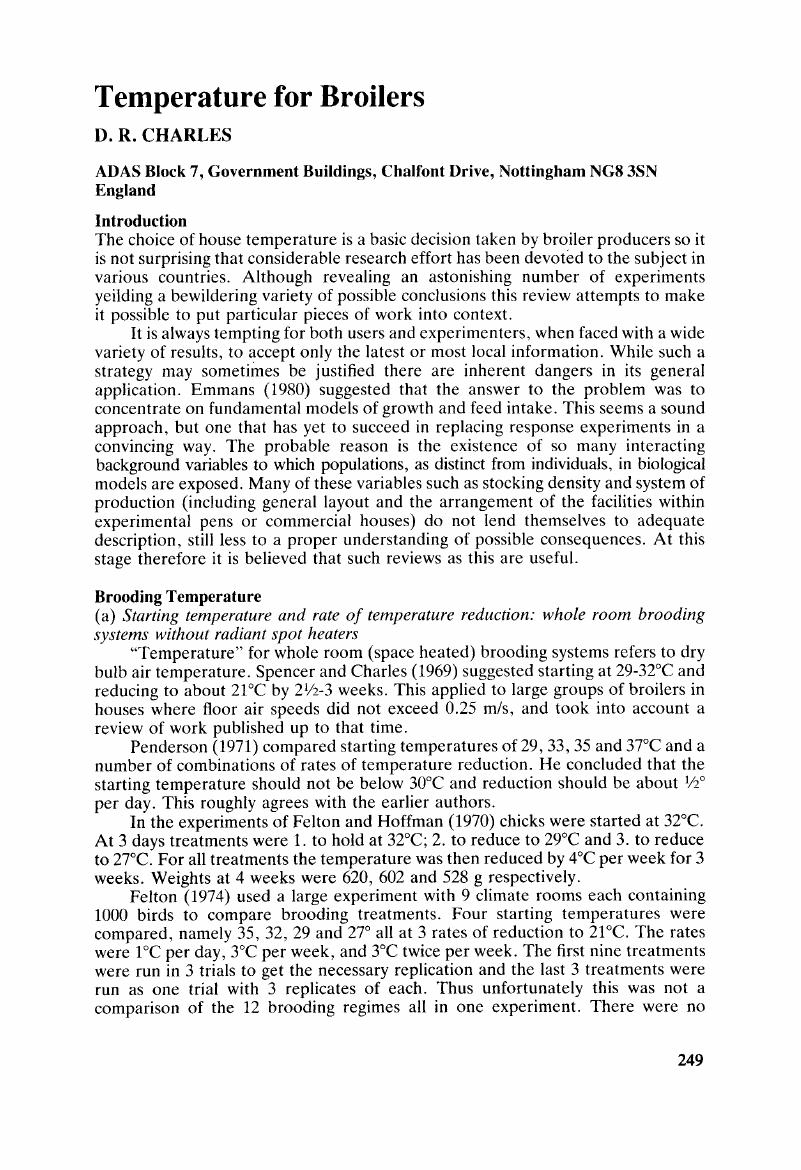Crossref Citations
This article has been cited by the following publications. This list is generated based on data provided by Crossref.
Donkoh, A.
1989.
Ambient temperature: a factor affecting performance and physiological response of broiler chickens.
International Journal of Biometeorology,
Vol. 33,
Issue. 4,
p.
259.
Alsam, Huda
and
Wathes, C. M.
1991.
Thermal preferences of chicks brooded at different air temperatures.
British Poultry Science,
Vol. 32,
Issue. 5,
p.
917.
Alsam, Huda
and
Wathes, C. M.
1991.
Conjoint preferences of chicks for heat and light intensity.
British Poultry Science,
Vol. 32,
Issue. 5,
p.
899.
Boshouwers, F. M. G.
Davelaar, F. G.
Landman, W. J. M.
Nicaise, E.
and
Van den Bos, J.
1996.
Vertical temperature profiles at bird level in broiler houses.
British Poultry Science,
Vol. 37,
Issue. 1,
p.
55.
BAZIZ, HACINA AIN
GERAERT, P.A.
PADILHA, J.C.F.
and
GUILLAUMIN, SOLANGE
1996.
Chronic Heat Exposure Enhances Fat Deposition and Modifies Muscle and Fat Partition in Broiler Carcasses.
Poultry Science,
Vol. 75,
Issue. 4,
p.
505.
Xin, H.
1997.
Mortality and Body Weight of Breeder Chicks as Influenced by Air Temperature Fluctuations.
Journal of Applied Poultry Research,
Vol. 6,
Issue. 2,
p.
199.
May, JD
Lott, BD
and
Simmons, JD
1998.
The effect of environmental temperature and body weight on growth rate and feed:gain of male broilers.
Poultry Science,
Vol. 77,
Issue. 4,
p.
499.
Temim, S.
Chagneau, A.M.
Guillaumin, S.
Michel, J.
Peresson, R.
and
Tesseraud, S.
2000.
Does excess dietary protein improve growth performance and carcass characteristics in heat-exposed chickens?.
Poultry Science,
Vol. 79,
Issue. 3,
p.
312.
May, J.D.
and
Lott, B.D.
2000.
The effect of environmental temperature on growth and feed conversion of broilers to 21 days of age.
Poultry Science,
Vol. 79,
Issue. 5,
p.
669.
May, J.D.
Lott, B. D
and
Simmons, J. D
2000.
The effect of air velocity on broiler performance and feed and water consumption.
Poultry Science,
Vol. 79,
Issue. 10,
p.
1396.
May, J.D.
and
Lott, B.D.
2001.
Relating Weight Gain and Feed:Gain of Male and Female Broilers to Rearing Temperature.
Poultry Science,
Vol. 80,
Issue. 5,
p.
581.
Ward, J.M.
Houston, D.C.
Ruxton, G.D.
McCafferty, D.J.
and
Cook, P.
2001.
Thermal resistance of chicken ( Gallus domesticus ) plumage: A comparison between broiler and free-range birds.
British Poultry Science,
Vol. 42,
Issue. 5,
p.
558.
Pope, T.
and
Emmert, J.L.
2002.
Impact of phase-feeding on the growth performance of broilers subjected to high environmental temperatures.
Poultry Science,
Vol. 81,
Issue. 4,
p.
504.
Koknaroglu, Hayati
and
Atilgan, Atilgan
2007.
Effect of Season on Broiler Performance and Sustainability of Broiler Production.
Journal of Sustainable Agriculture,
Vol. 31,
Issue. 2,
p.
113.
Dozier, W.A.
Purswell, J.L.
Kidd, M.T.
Corzo, A.
and
Branton, S.L.
2007.
Apparent Metabolizable Energy Needs of Broilers from Two to Four Kilograms as Influenced by Ambient Temperature.
Journal of Applied Poultry Research,
Vol. 16,
Issue. 2,
p.
206.
Dozier, W.A.
Corzo, A.
Kidd, M.T.
and
Branton, S.L.
2007.
Dietary Apparent Metabolizable Energy and Amino Acid Density Effects on Growth and Carcass Traits of Heavy Broilers.
Journal of Applied Poultry Research,
Vol. 16,
Issue. 2,
p.
192.
Dozier, W.A.
Corzo, A.
and
Kidd, M.T.
2008.
Apparent Metabolizable Energy Needs of Broiler Chicks Subjected to Diverse Ambient Temperature Regimens.
Journal of Applied Poultry Research,
Vol. 17,
Issue. 1,
p.
134.
Olanrewaju, H.A.
Purswell, J.L.
Collier, S.D.
and
Branton, S.L.
2010.
Effect of Ambient Temperature and Light Intensity on Growth Performance and Carcass Characteristics of Heavy Broiler Chickens at 56 Days of Age.
International Journal of Poultry Science,
Vol. 9,
Issue. 8,
p.
720.
Widowski, Tina
2010.
The Welfare of Domestic Fowl and Other Captive Birds.
Vol. 9,
Issue. ,
p.
137.
Beg, M.A.H.
Baqui, M.A.
Sarker, N.R.
and
Hossain, M.M.
2011.
Effect of Stocking Density and Feeding Regime on Performance of Broiler Chicken in Summer Season.
International Journal of Poultry Science,
Vol. 10,
Issue. 5,
p.
365.


